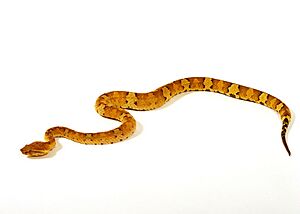Craspedocephalus puniceus facts for kids
Quick facts for kids Craspedocephalus puniceus |
|
|---|---|
 |
|
| Scientific classification | |
| Genus: |
Craspedocephalus
|
| Species: |
puniceus
|
| Synonyms | |
|
|
The flat-nosed pitviper (scientific name: Craspedocephalus puniceus) is a type of venomous snake found in Southeast Asia. It's also known as the ashy pit viper. This snake is a pit viper, which means it has special heat-sensing pits on its head. These pits help it find warm-blooded prey, even in the dark. No different types (subspecies) of this snake are officially recognized right now.
Contents
What Does the Flat-Nosed Pitviper Look Like?
Adult flat-nosed pitvipers can grow up to about 64 cm (25 in) long. This measurement includes their tail, which can be around 9 cm (3.5 in) long. Their tail is special because it's prehensile, meaning they can use it to grab onto branches, just like a monkey uses its tail.
Colors and Patterns
The top of the snake's body can be gray, brown, or red. It often has dark spots or stripes that might connect to form a wavy pattern. Behind each eye, there's usually a light-colored streak. The underside of the snake is often speckled with dark brown, and it might have a row of yellowish spots along its sides.
How Big Do They Get?
The size of a flat-nosed pitviper depends on whether it's a male or a female.
- Adult male snakes are usually between 60 to 70 cm long.
- Adult female snakes are larger, typically ranging from 100 to 130 cm in length.
Snake Scales: A Closer Look
Snakes have different types of scales that help scientists identify them. The flat-nosed pitviper has:
- 21 to 23 rows of scales around the middle of its body. These scales are slightly ridged, which is called "keeled."
- 158 to 173 large scales on its belly, called "ventral scales."
- 41 to 56 scales under its tail, known as "subcaudal scales."
- 10 to 13 scales above its mouth, called "supralabial scales."
The large scale covering its vent (where waste exits) is a single, undivided scale.
Understanding the Flat-Nosed Pitviper's Venom
The flat-nosed pitviper's bite can inject venom, which is a serious issue in some parts of the world, especially in Asia. Scientists study this snake's venom to understand its effects. This research helps them learn how the venom works and how to treat bites.
How Venom Affects the Body
Studies have shown that the more concentrated the venom, the stronger its effects on red blood cells. When red blood cells are affected, their shape can change. This change in shape is called "morphology." Understanding these changes helps researchers develop better ways to help people who have been bitten.
Where Do Flat-Nosed Pitvipers Live?
You can find the flat-nosed pitviper in several places across Southeast Asia. Its natural home includes:
- Southern Thailand
- West Malaysia
- East Malaysia (in areas like Sabah and Sarawak)
- Indonesia, specifically on islands such as Borneo, Sumatra, the Mentawai Islands (like Siberut and North Pagai), Simalur, and Java.
The first specimen of this snake that scientists studied came from "Java."

